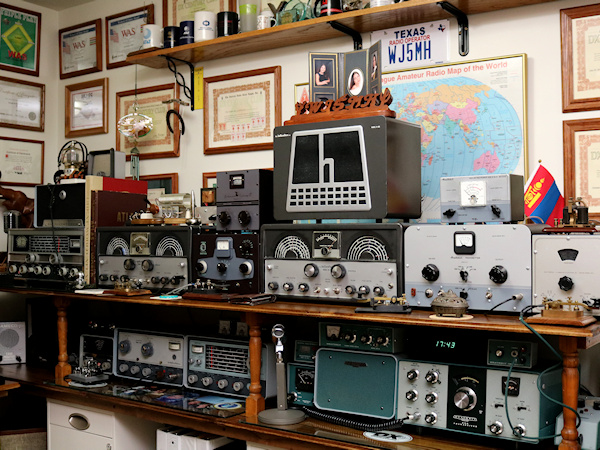The Radio Room Main Operating Positions
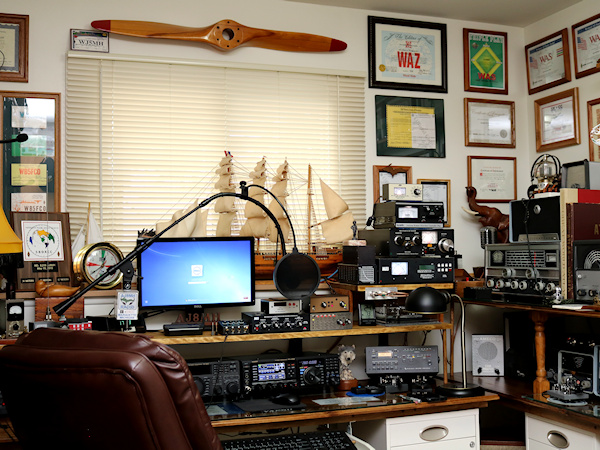
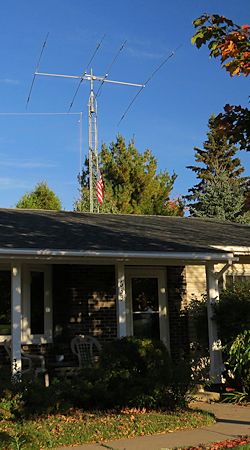
A Very Short Autobiography
 I was first licensed by the FCC (Federal
Communications Commission) in 1961 as WN8AQL in Marquette, MI. In
addition, I operated from Biloxi, MS and Austin, TX, and held the call-signs WB5FCO and WJ5MH. AJ8MH was issued September 26, 2008. My wife, Pam, was licensed March 20, 2009, and
holds the call-sign KD8KMN.
I was first licensed by the FCC (Federal
Communications Commission) in 1961 as WN8AQL in Marquette, MI. In
addition, I operated from Biloxi, MS and Austin, TX, and held the call-signs WB5FCO and WJ5MH. AJ8MH was issued September 26, 2008. My wife, Pam, was licensed March 20, 2009, and
holds the call-sign KD8KMN.
AJ8MH is a member of ARRL, and the Hiawatha Amateur Radio Association of Marquette County. AJ8MH has also been a member of FISTS (#14321),
SKCC (#5857), AMSAT, YL - ISSB
(#9420), QRP - ARCI (#3904) and 10-10 (#5991).
 My interest in electronics started in early 1961
when I was just eleven years old. Not too long after my initial interest, I studied and tested for my
Novice amateur radio license. At fifteen, I took the FCC (Federal Communications Commission) exam for
the 3rd Class Broadcast Permit, and started to work for Lake Superior Broadcasting (WDMJ AM/FM). I
worked for them while in high school and college, and I also worked, for a limited time, at Northern Michigan
University's WNMR-FM.
My interest in electronics started in early 1961
when I was just eleven years old. Not too long after my initial interest, I studied and tested for my
Novice amateur radio license. At fifteen, I took the FCC (Federal Communications Commission) exam for
the 3rd Class Broadcast Permit, and started to work for Lake Superior Broadcasting (WDMJ AM/FM). I
worked for them while in high school and college, and I also worked, for a limited time, at Northern Michigan
University's WNMR-FM.
In 1968, I joined the United States Air Force and trained as an air-traffic control radar technician serving
in Amarillo, Texas; Biloxi, Mississippi (I survived hurricane Camille while in Mississippi in 1969); Nakhon
Phanom, Thailand; and Austin, Texas. During my tour of duty in Thailand as a radar tech, I did
volunteer work for the Military Affiliate Radio Service (MARS Call-signs AI8NP and AIA8NP), and the American
Forces Thailand Network (AFTN/AFRTS).
Military Service Notes (1968-1972): Air Force Communications Service (AFCS) Air Traffic Control Radar
Maint 3380th CMS Squadron Keesler AFB Biloxi MS - 1987th Comm Squadron Nakhon Phanom (NKP) Thailand - 2013th
Comm Squadron Bergstrom AFB Austin TX - Volunteer work: Air Force 6001st Support Squadron AFTN/AFRTS Nakhon
Phanom (NKP) Thailand.
After leaving the Air Force in 1972, I worked 2 years for Gulf Coast Broadcasting in Gulfport,
Mississippi. I was a Top 40 DJ for WROA (The Rock of America), and program director for WROA FM.
In October of 1974, I started working for Teltronic Communications, a Motorola Service Center, and this is
when I tested and was granted my "commercial" license issued by the FCC in New Orleans.
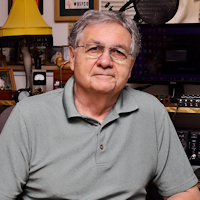
 In 1978, I left Mississippi and moved to Austin, TX.
I worked as a radio technician for Austin Communications, another Motorola Service Center. I also
worked part-time for KOKE/KKMJ (Majic 95 FM). Austin was the birthplace of my daughter, born on "Cinco
de Mayo," 1981.
In 1978, I left Mississippi and moved to Austin, TX.
I worked as a radio technician for Austin Communications, another Motorola Service Center. I also
worked part-time for KOKE/KKMJ (Majic 95 FM). Austin was the birthplace of my daughter, born on "Cinco
de Mayo," 1981.
I started my cellular communication career as a technician for McCaw (Cellular One) in 1987, and quickly
moved into engineering then management. Some years were better than others, but my personal
satisfaction greatly diminished when the McCaw / AT&T Wireless operation was sold in late 2004 to
Cingular Wireless and the organizational culture changed. When Cingular was renamed to AT&T
Mobility, it was certainly not the original AT&T that I enjoyed working for.
In February 2008, after 21 years with AT&T Mobility (Cingular / AT&T Wireless / McCaw Communications)
I retired as Operation's Manager and joined the ranks of the unemployed. Having enough of the big city
life, I left Austin, Texas and moved back "home" to Marquette in the Upper Peninsula of Michigan, fully
realizing that most people move south when they retire.
After settling in Marquette, I worked a little over a year with a great staff at Northern Star Broadcasting;
a group of 2 AM and 3 FM stations including WDMJ and WJPD-FM. I decided to completely retire shortly
after the stations were sold to Sovereign Communications in 2010. The sale didn't have anything to do
with my decision. It was just time to close another chapter of my life.
Since 1960, with my Kodak Brownie Starmite camera, I've had an interest in photography. I've had
several cameras over the years and with the advent of digital photography and photo editing software, I've
taken a renewed interest. Designing web pages is an interest that parallels photography. Both
hobbies, allow me to release some of my artistic abilities.
(Visit Flickr Photostream to view my photographs.)
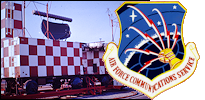
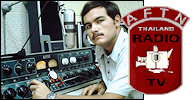
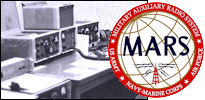
Station and Activities
 The radio-room (my little museum) in Michigan is
on-the-air. Current antennas include a Mosley TA-33-M-WARC (4 element beam) at 36', and a 102 foot
inverted-V doublet (broadside NW/SE).
The radio-room (my little museum) in Michigan is
on-the-air. Current antennas include a Mosley TA-33-M-WARC (4 element beam) at 36', and a 102 foot
inverted-V doublet (broadside NW/SE).
Over the years, I've experimented with packet satellites, most of the digital modes, antennas, built QRP
rigs, and I've operated in many contests. In 2002, I found duplicates of the Hallicrafters equipment I
had during the sixties. I refurbished all of it, and actually use the station.
Refurbishing the old station lead to many other projects including an RCA Radiola, a Hallicrafters SX-16 and
SX-99, an Echophone EC-1, Heathkit AT-1 transmitter and a complete Heathkit HW-101 station. I've also
refurbished a small collection of telegraph equipment manufactured by Signal Electric of Menominee,
Michigan.
Check the Site Map for pictures and links to many of my
projects.
 These days, you'll find me chasing DX as I try to
add to my DXCC Honor Roll total. There are entities (countries) left on my list, but unfortunately,
activity for these few is very limited or nonexistent. I also chase entities for the Challenge
Award. Links to my tracking spreadsheets are listed under "A Few Accomplishments" below, and they're
updated quite often.
These days, you'll find me chasing DX as I try to
add to my DXCC Honor Roll total. There are entities (countries) left on my list, but unfortunately,
activity for these few is very limited or nonexistent. I also chase entities for the Challenge
Award. Links to my tracking spreadsheets are listed under "A Few Accomplishments" below, and they're
updated quite often.
I've managed to assemble a good station since I returned home, and for the first time in 60 plus years of ham
radio, I now use a small amplifier to help me compete with the "big boys."
73, and hope to work you on the bands...again, or for the first time.
~ Joe [ AJ8MH ]
1) The Beginning 1961 through 1971 2) The Early Active Years 1972 through 2007 3) Today (This Page )



DX Code of Conduct
1) I will listen, and listen, and then listen again before calling.
2) I will only call if I can copy the DX station properly.
3) I will not trust the cluster and will be sure of the DX station's call sign before calling.
4) I will not interfere with the DX station nor anyone calling and will never tune up on the DX
frequency or in the QSX slot.
5) I will wait for the DX station to end a contact before I call.
6) I will always send my full call sign.
7) I will call and then listen for a reasonable interval. I will not call continuously!
8) I will not transmit when the DX operator calls another call sign, not mine.
9) I will not transmit when the DX operator queries a call sign not like mine.
10) I will not transmit when the DX station requests geographic areas other than mine.
11) When the DX operator calls me, I will not repeat my call sign unless I think he has copied it
incorrectly.
12) I will be thankful if and when I do make a contact.
13) I will respect my fellow hams and conduct myself so as to earn their respect.
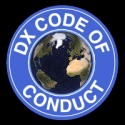 *14) I will have patience and ignore the jerks, especially the
pile-up police, on frequency tuners, wrong VFO space-cadets, other jammers, pirates, all other LIDS, the
ill-mannered and the inexperienced, both on frequency and on the DX cluster.
*14) I will have patience and ignore the jerks, especially the
pile-up police, on frequency tuners, wrong VFO space-cadets, other jammers, pirates, all other LIDS, the
ill-mannered and the inexperienced, both on frequency and on the DX cluster.
*15) I will remember that the technology can be turned off, and I can do something more productive to
pass the time.
"I'm often asked what you can do to help amateur radio and help enforcement. There's several things you can do. One is, don't engage people and don't humor the idiots. We have a certain number of idiots, just like the legal profession does, the plumbers profession, medical, whatever. It's just our society."
"But, stupidity can't be regulated, no matter how good the rules are. The thing you do to help the
most, is to just turn the big knob. Every rig has one. Whether the transceiver has 20 buttons or
77, it has one big knob."
Riley Hollingsworth, Retired Special Counsel, FCC Enforcement (11/2014)



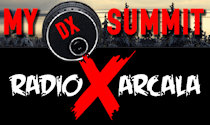
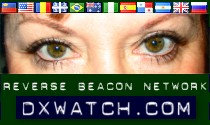

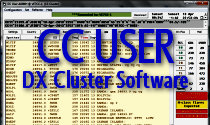
A Few Accomplishments

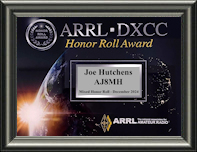
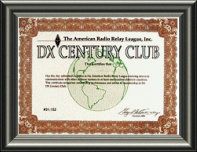
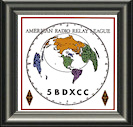
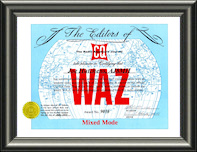
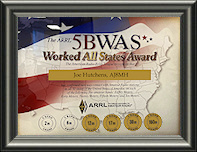
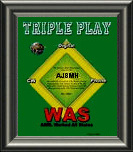
 Downloads:
Downloads:
WAS Tracking ( WAS Tracking ~ ARRL
LoTW ~ LibreOffice/Excel Spreadsheet )
WAS Digital Tracking ( WAS
Digital Tracking ~ ARRL LoTW ~ LibreOffice/Excel Spreadsheet )
DXCC Tracking ( DXCC Tracking ~
QSL Card and ARRL LoTW ~ LibreOffice/Excel Workbook )
 DXCC (Mixed) total is 339 worked and 339 confirmed. (Includes deleted
entities.)
DXCC (Mixed) total is 339 worked and 339 confirmed. (Includes deleted
entities.)
 DXCC Honor Roll (Mixed) December 2024.
DXCC Honor Roll (Mixed) December 2024.
 Many awards have been received over the years
from ARRL, and I'm still actively pursing Challenge Award points. Awards have also been received from
CQ (WAZ), eQSL and QRZ.
Many awards have been received over the years
from ARRL, and I'm still actively pursing Challenge Award points. Awards have also been received from
CQ (WAZ), eQSL and QRZ.
Vintage Stations
Detailed photographs of the station equipment can be viewed at:( www.aj8mh.com/todayphoto.html )




